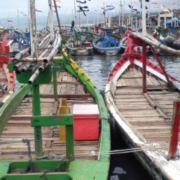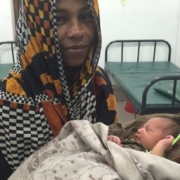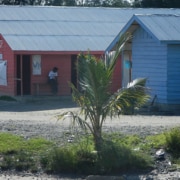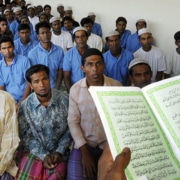
Asylum seekers and refugees are excluded from public services like healthcare and education. Photo by FB Anggoro for Antara.
There are an estimated 14,000 refugees and asylum seekers in Indonesia. But an unclear legal framework and the unwillingness of politicians to deal with the issue has meant that many genuine asylum seekers and refugees continue to be treated as illegal immigrants.
Many face administrative or penal measures, including mandatory detention, fines, and deportation. Even if they don’t, they are still excluded from public services, including healthcare and education, and do not have access to adequate housing or employment. Neither can they enjoy freedom of movement like other Indonesian citizens.
With prospects for settlement in third countries slim, Indonesia desperately needs to resolve the inconsistency between refugee policy and practice if it is to respect and protect the rights of asylum seekers and refugees who may be in the country for years to come.
Legal inconsistency
It is well known that Indonesia is not a signatory to the 1951 Convention Relating to the Status of Refugees. However, the right to seek asylum is now recognised in the Indonesian Constitution (following the second amendment in 2000), Law No. 39 of 1999 on Human Rights, and Law No. 37 of 1999 on Foreign Relations.
Indonesia is also party to core international human rights conventions and has adopted human rights standards into its domestic legislation. It is therefore bound by international and domestic legal obligations to uphold these rights. The most important provision relevant to asylum seeker and refugee protection is the recognition that everyone has equal rights to enjoyment of the rights set forth in these conventions, without discrimination.
In 2016, the government issued Presidential Regulation No. 125 of 2016 on the Treatment of Refugees and Asylum Seekers in Indonesia. This regulation recognised the fundamental right to seek asylum and refuge and was hailed by many as a step forward in Indonesia’s treatment of asylum seekers and refugees.
But it remains an insufficient legal framework for the rights of refugees and asylum seekers. It is focused mainly on technical guidelines for government agencies when refugee-related situations occur. None of the internationally recognised rights attached to refugees are stipulated in the presidential regulation.
There are also many inconsistencies between the international human rights instruments, the Constitution, domestic statutes and regulations, which create confusion and misconceptions among government officials, police, the judiciary, and civil society about the place of these rights in the Indonesian legal system. This inconsistency can be seen in the table below:
The table shows that many refugee rights stipulated under the 1951 Refugee Convention are also recognised in the Indonesian Constitution, domestic laws, and international human rights treaties that Indonesia has acceded to. The 2016 Presidential Decree is inconsistent with these principles, and in some cases even imposes discriminatory treatment.
Immigration challenges
The primary mistake governments make with refugee policy and practice is when they follow a conventional immigration framework or perspective. When asylum seekers and refugees are viewed simply through the lens of not having valid travel documents, they are easily classed as illegal immigrants.
The Indonesian immigration regime does not apply any distinction between regular immigrants and asylum seekers or refugees. In fact, Law No. 6 of 2011 on Immigration does not even include asylum seeker or refugee terminology in its provisions. Although the Law includes an exclusionary clause for victims of people smuggling and human trafficking under Articles 86 and 87, these clauses do not clearly include asylum seekers or refugees as victims of people smuggling or human trafficking who deserve to be treated differently to illegal immigrants.
Similarly, immigration officers are not equipped with sufficient knowledge and capacity beyond the provisions of the 2011 Immigration Law. As well as the problem of lack of knowledge and capacity, the absence of provisions relating to refugees and asylum seekers in the Immigration Law means that immigration is not supported financially or equipped with sufficient infrastructure to deal with asylum seekers and refugees. Indonesia’s overcapacity immigration detention centres are just one result of this legal gap.
The only current policy directly related to asylum seekers and refugees in the immigration legal framework is a discretionary circular issued in 2002 (later amended in 2010) instructing immigration offices to put illegal immigrants who claim asylum in touch with the UNHCR. Unfortunately, the circular also outlined a series of prohibitions, including a prohibition on refugees and asylum seekers participating in any income-generating activities.
Given that the Immigration Law was not intended to deal with refugees and asylum seekers, immigration authorities should not step in and apply immigration law and policies to them. Within the Indonesian immigration framework, most refugees and asylum seekers could be regarded as victims of people smuggling or, in some cases, human trafficking, meaning they should be protected and excluded from any punitive measures under the Law.
The rights of asylum seekers and refugees should be recognised and protected, as they are outlined in the Indonesian Constitution, the Human Rights Law, and the Foreign Relations Law. Even if this was done, however, there would still be a need for a comprehensive law on asylum seekers and refugees that clarified their recognised and protected rights, the role of government and society, supporting mechanisms and infrastructure, and funding.
Such a law would overcome the current confusion. Legal reform would also be a catalyst for helping the government and society strengthen their knowledge and capacity and better prepare themselves for dealing with refugee populations into the future. Until this is done, the 14,000 asylum seekers and refugees already in Indonesia, with few chances for resettlement, remain trapped in a cycle of poverty and discrimination, with little hope for improvement.
This article is an outcome of a workshop, ‘Presidential Regulation No 125 of 2016 on the Treatment of Refugees and Asylum Seekers in Indonesia: Opportunities and Challenges’, held on 21-22 March 2019 under an Australian Research Council grant and hosted by the Faculty of Law, University of Indonesia. Febi Yonesta was a participant in the workshop.











